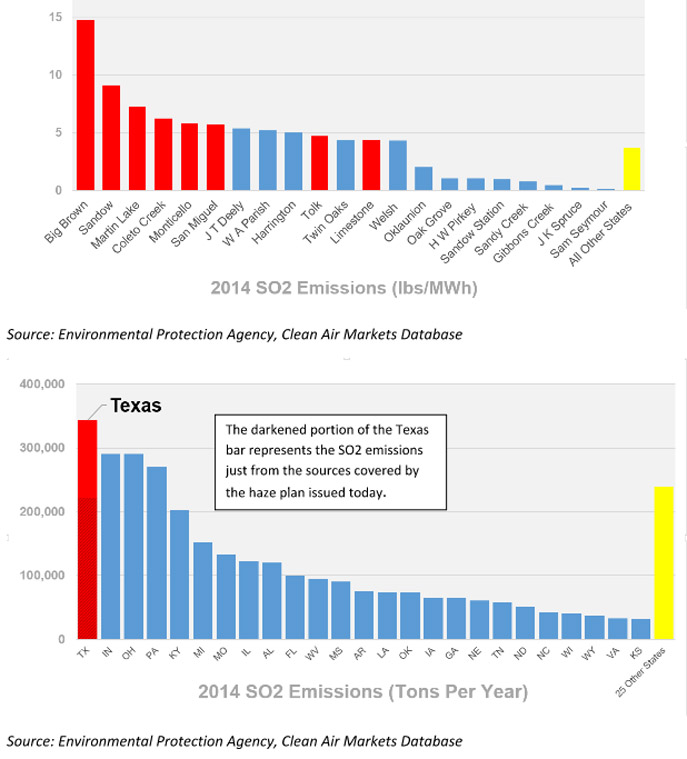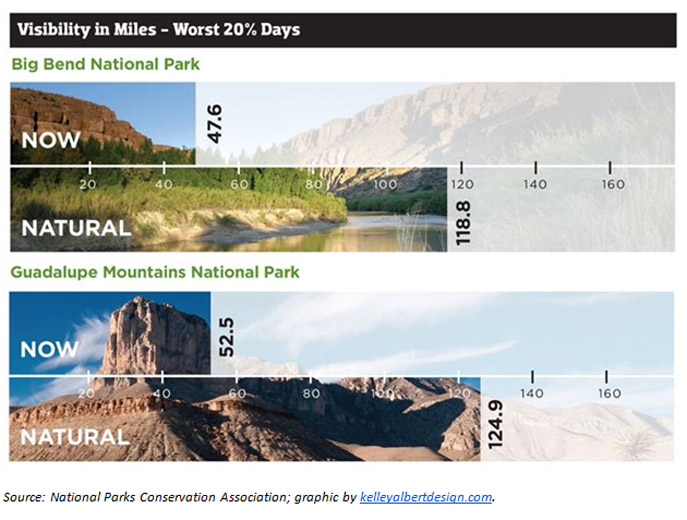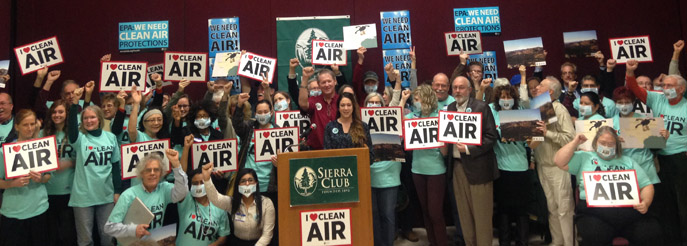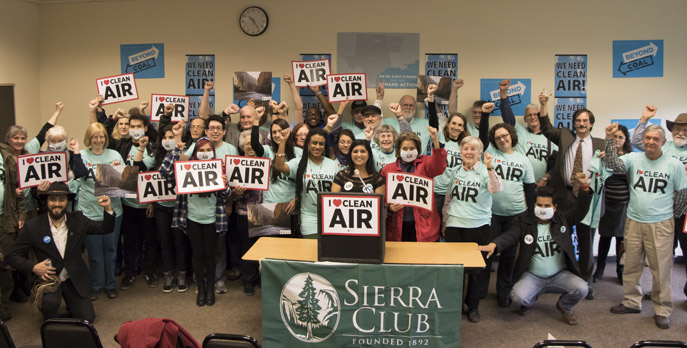EPA Rejects State's Do-Nothing Plan on Haze Pollution
"Everything's bigger in Texas," the saying goes. Unfortunately, that includes the amount of air pollution Texas coal-burning power plants pump into the state's communities every day. Any list of the biggest polluters nationwide of mercury, greenhouse gases, or sulfur dioxide, includes Texas sources at the top.[1] A new safeguard finalized today by the U.S. Environmental Protection Agency aims for a major cleanup of some of the most polluting culprits.
The new standard, known as the Texas Regional Haze Plan, targets sulfur dioxide, a pollutant that leads to haze and fine particulate pollution downwind. Texas sources emit more sulfur dioxide than regional neighbors Oklahoma, Arkansas, Louisiana, New Mexico and Mississippi combined. This isn't just because Texas is a big state with big energy needs. No, Texas power plants are especially dirty and their owners are especially resistant to installing modern pollution controls. A plant's sulfur dioxide emissions rate (pounds per megawatt hour) is a measure of how dirty a plant is per unit of energy produced. The sulfur dioxide emissions rate at Texas's dirtiest plants is exceptionally high -- far higher than plants with updated pollution controls (on the right side of the graph below), and far higher than the average rate of plants in all other states (in yellow). The worst offenders are the plants run by Luminant Generation Corporation, Texas's largest power company. The Luminant plants' average sulfur dioxide rate ranks third highest among the nation's largest 100 power producers.[2] The air permit for its Big Brown plant allows sulfur dioxide pollution at a rate that is 75 times higher than what plants with modern technology can achieve.

High levels of sulfur dioxide harm people in the neighborhood of Texas plants, which is bad enough, but much of the pollution also travels many miles downwind and morphs into what's called fine particulate matter -- tiny particles that lodge deep in your lungs. Particulate pollution causes even more dire health problems, especially for kids and the elderly, and also contributes to hazy skies.
Better Late than Never: EPA's Haze Plan
That's where the "regional haze plan" comes in. Way back in 1977, Congress amended the Clean Air Act to recognize that manmade pollution was marring the scenic vistas in parks like Texas's Big Bend, and ordered air regulators to do something about it. Congress spoke clearly, mandating a return to the clear views that would exist if manmade pollution were eliminated. When the EPA finalized its Regional Haze Rule in 1999, it required states to take steps achieve this goal of "natural visibility" by the year 2064. States were required to submit plans by 2007 to make reasonable progress towards the goal, and if those plans were inadequate, the EPA would have to step in and create a plan in place of the state.
After prodding by EPA, Texas submitted its plan in 2009. What did Texas propose to do? Exactly what you'd expect for the state that has sued to block every major federal air regulation in recent memory: absolutely nothing. Despite the exceptional amount of haze-causing pollution being released by Texas coal-fired power plants, and readily available technology to address that problem, Texas proposed that those plants should have to do no more than they are already doing to meet other air regulations. Even in the face of those regulations, many of these sources have avoided installing modern scrubbers, which are now able to reduce sulfur dioxide emissions by 98 percent. As the Texas Monthly put it, "Luminant saved billions by not investing in the types of scrubbers ... that many of their competitors installed years ago." Some of the Luminant sources addressed by the haze plan have subpar scrubbers, which the company does not even use to treat the full volume of gases being released out its stacks.
After public and legal pressure from the Sierra Club, along with allies like Earthjustice and National Parks Conservation Association, the EPA carefully reviewed the Texas plan and called foul. The National Park Service also criticized Texas's assertion that it was already doing enough to prevent haze, especially when compared with other states. According to Texas's proposed plan, Big Bend National Park would not achieve natural visibility conditions until 2155 -- 91 years after the 2064 goal and 140 years from today.
Today, at long last, the EPA is finalizing a regional haze plan that requires power plants that are some of the dirtiest in Texas -- or any state -- to clean up.
The EPA rejected Texas's do-nothing haze plan because the state did not properly recognize that many of the facilities contributing to hazy parks could reduce their sulfur dioxide pollution for a relatively low cost-per-ton reduction. To make progress towards natural visibility, the EPA is requiring that eight coal-fired power plants cut their sulfur dioxide pollution to the levels that many other plants in the nation have already achieved.
To meet the limits set in the EPA's plan, three coal-fired power plants would need to install new scrubbers and four plants would need to upgrade the 1970s-era scrubbers they already have.[3] The plants' owners could also choose to retire these aging plants and replace them with cleaner energy (some of the plants are already failing to turn a profit for much of the year). The end result? More than 231,000 tons of sulfur dioxide taken out of the air every year. That’s about 60 percent of Texas's annual sulfur dioxide pollution and 7 percent of the sulfur dioxide pollution reported by major sources across the entire country. Because this cleanup will reduce fine particulate pollution formed downwind, it will help clear the skies in national parks throughout the entire region. These include beloved areas like Big Bend National Park and the Guadalupe Mountains National Park in Texas, the Wichita Mountains National Wildlife Refuge in Oklahoma, and Caney Creek Wilderness in Arkansas. It will also have a staggeringly important impact on public health -- potentially saving hundreds of lives per year.

Sounds great, right? That's not what you'll hear from the companies whose bottom lines are affected, nor their friends in the Texas establishment. You'll hear predictions that the lights will go out, electricity prices will go up, and the Texas economy will suffer. We know this because this is what these companies say every time a life-saving standard comes out. Rewind to 2011 when EPA put forward another standard aiming to reduce sulfur dioxide from these same plants, called the Cross State Air Pollution Rule. Luminant predicted the new standard would cause "severe reductions in electrical generation," a "substantial increase in wholesale and retail electricity prices," and claimed that "the broader impacts to Texas will be staggering," and "over a thousand jobs will be eliminated."[4] Well, the Cross-State Air Pollution rule went into effect in January 2015, after Luminant and other companies succeeded in temporarily delaying it in court, and none of these dire impacts have come to pass. And there’s an interesting side note: soon after the court ordered the rule's delay, Luminant announced it would shutter two units at its Monticello plant for most of the year because they weren't making enough money regardless. Later, it announced it would be closing -- for unrelated economic reasons -- one of the same mines it warned would be closed due to the rule's implementation. "The company determined it was cheaper to import coal from a deposit that spans Montana and Wyoming than mine it in Texas," a Luminant spokesperson explained.
The Cross-State Air Pollution Rule story is telling. Economics is to blame for the inability of these plants to compete. As coal becomes uncompetitive in Texas energy markets, it may make economic sense for companies to retire their coal plants. What is not for certain is how the plants' owners will handle the transition. They could blame safeguards like the Texas Regional Haze plan, and fight against clean up to the death, leaving a cloud of uncertainty during protracted litigation. Or they could acknowledge the economic forces at work, make a plan for both compliance and economic viability, and provide ample advance warning of potential plant retirements to communities, workers, and the grid operator.
In certain other states like Oklahoma and New Mexico where the EPA had to step in with a haze plan, the agency has welcomed the opportunity to work with plant owners to develop source-specific timelines for regional haze compliance, while achieving the necessary pollution reductions through plant retirements. For instance, instead of putting on sulfur-dioxide scrubbers at its Northeastern coal plant in Oklahoma in the five-year time frame initially required by the EPA, American Electric Power worked out a plan to gradually phase out its Northeastern plant by retiring one unit in 2016 and ramping the other's production down gradually to full retirement by 2025 or 2026. If the Texas companies affected by the haze plan so desire, they could approach the EPA with a similar strategy.
Toward a Clean and Reliable Grid
As for the "lights-will-go-out" claim we've heard time and again, the Texas grid is rapidly evolving from a coal-centric system to one that is more flexible and clean. Texas already produces more wind power than any other state, and ranks first in the nation for solar energy potential. New wind projects totaling 11,000 megawatts have agreements signed to be online by 2017, and solar is rapidly expanding as well. Well before the Texas Regional Haze Plan was proposed, the grid operator, Electric Reliability Council of Texas (ERCOT), predicted that coal would make up 25 percent of generated energy in 2029 in most scenarios, down from 34 percent today. This is good news for the reliability of the grid. ERCOT has recognized that flexibility is key for supporting a renewables-based grid. Coal-burning power plants are not flexible: they take a long time to start up and are inefficient to ramp up and down. And coal plants have been the source of problems, not solutions, in recent Texas grid emergencies. For example, equipment failures at several of the plants covered by the haze rule contributed to emergency grid operations during a cold weather snap in early 2014.
Whatever impacts the Texas Regional Haze Plan may have, ERCOT is constantly studying and reevaluating what types of changes to the grid and to the electricity market will ensure that Texans have a reliable electric grid. (They will have to do better than the highly problematic report on the haze plan they released in October.) Over 1,000 miles of transmission lines have been rebuilt or upgraded this year to make a stronger more flexible grid. Demand response -- programs providing incentives for consumers to shift the timing of their electricity use -- and other market tools are increasingly available to reduce electricity needs at peak times. While Texas is far behind other states in its energy efficiency programs for consumers, increasing energy efficiency by just a small percentage of electricity sales could eliminate the need for three large coal units, according to one study. In short, there are ways to reduce the grid's reliance on these dirty coal plants if the companies make a business decision to retire instead of clean up.
Companies like Luminant will fight tooth and nail to avoid coming up to the modern pollution control standards many of their peers achieved long ago. We at the Sierra Club are celebrating this hard-fought victory for clean air, healthy communities, and miles upon miles of beautiful views.

Concerned citizens from Texas and Oklahoma rally for a strong Texas haze plan.
[1] See here, here, and here for example.
[2] MJ Bradley & Associates, Benchmarking Air Emissions of the 100 Largest Power Producers in the United States, p. 34, Table 2; Figure 14, p. 39. Luminant is the power generation subsidiary of Energy Future Holdings (EFH). The sulfur dioxide rate from coal-fired power plants is averaged with cleaner sources owned by EFH, and EFH is still in the top three among its peer power producers.
[3] The plants that would need new scrubbers are Luminant’s Big Brown and Monticello (Units 1 &2), GDF Suez’s Coleto Creek, and the Tolk plant, operated by Southwestern Public Service Company. The plants that would need scrubber upgrades are Luminant’s Martin Lake, Sandow 4, and Monticello (Unit 3), and NRG’s Limestone. The eighth plant, San Miguel, would need to reduce its emissions but would be able to meet its required limit without installing new equipment.
[4] EM Homer City v. EPA, United State Court of Appeals for the District of Columbia, Case 11-1315, Doc. 1329866.
